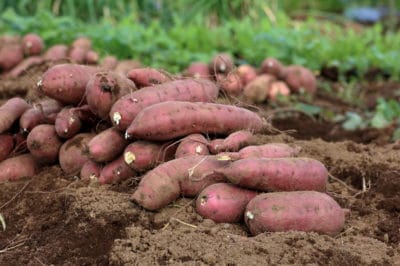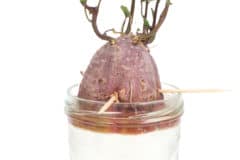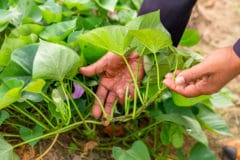Sweet Potato as a Food Crop
Although in the US, sweet potatoes are often a holiday delicacy, in developing countries, the tubers may be a major food source. The plant will grow at altitudes from sea level to over 8,000 feet. It does not take as much labor or water as crops like maize and rice. The plant will tolerate dry spells and poor soil, although the size and numbers of tubers may be reduced.
Sweet Potato Requirements
Sweet potatoes can be grown in any area where their basic requirements can be met. These include:
- A growing season of at least 150 days.
- Loose, friable, well drained soil of low to medium fertility.
- Adequate water – at least once inch per week.
- Soil and nighttime temperatures of at least 60 °F (16°C) when planted out.
Sweet Potato USDA Zones
Sweet potatoes need a long growing season – a minimum of 150 frost-free days. They do very well in USDA Zones 8 through 11, although they need irrigation in many areas to produce a decent crop. In the warmest areas, they may become perennial if they have a good water supply. Desert gardeners may be able to harvest two crops.
Cold Climates
Its frost sensitivity limits the sweet potato in colder USDA Zones. However, gardeners down to Zone 5, which has an average of 165 frost-free days, may still be able to grow a crop. The key is to start the slips indoors and grow in a greenhouse for a few weeks. Cover the soil with black plastic at least two or three weeks before planting out. Use short-season varieties like Georgia Jet.
In the United States
The southern United States produce the bulk of the commercial sweet potatoes in this country, although California also grows the tubers. North Carolina is the primary source of commercial sweet potatoes and produces about 60 percent of the commercial crop. It is followed in descending order by the states of California, Mississippi and Louisiana.
Worldwide Sweet Potato Production
China is the major producer of sweet potatoes, typically producing more than 70 million tons a year. Nigeria and Tanzania rank next, but their production is a fraction of China’s – on the order of 3 million tons a year. Ethiopia, Indonesia, Uganda and Vietnam also produce at least 1 million tons a year. In all countries but China, the crop is usually used by humans. Half or more of China’s crop is used for livestock feed.












